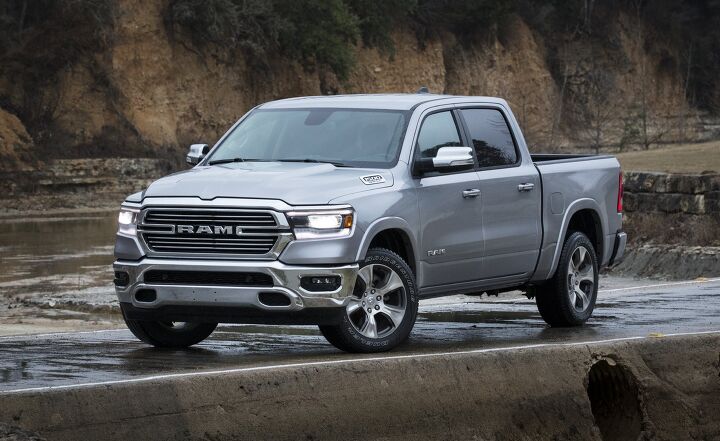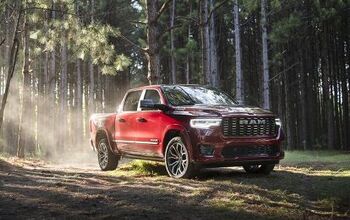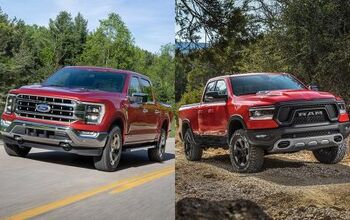Ram 1500 Big Horn Vs Laramie: Which Truck is Right for You?

The Ram 1500 is one of the best-selling vehicles in America.
With the country’s love affair for pickup trucks, this doesn’t come as much of a surprise. The Ram 1500 offers a lot of choice for those looking at a new truck. It can be configured to haul a lot of weight, float across the desert floor, or drop the kids off at school on the way to the grocery store.
Choosing which truck is right for you comes down to one’s priorities. What exactly are you looking for in a new truck, or more importantly, what tasks do you need it for? To help, we’re looking at two popular mid-trim models of Mopar’s full-size truck. It’s the Ram 1500 Big Horn vs Laramie. We’re pitting these two trucks head-to-head, battling over nine key categories to see what the differences are. Read on to see which truck is better suited for your life.
Ram 1500 Big Horn vs Laramie: Style
Pickup trucks come in a variety of body styles and the both the Big Horn and Laramie provide options. The Big Horn is available as a Quad Cab with the 6’4” pick-up box, or a Crew Cab with either the short 5’7” box or the long 6’4” box. The Laramie only comes as a Crew Cab with either the 5’7” or 6’4” box.
Both can look as utilitarian or fancy as one desires through various option packages. Either trim has the option to add the Sport Appearance Group, Night Edition Package, Protection Group, 4X4 Off-Road Group, or Trailer Tow Group. The Big Horn can also be equipped with the Back Country Equipment Group, and/or Premium Lighting Group.
The Laramie has a few unique appearance options, like adding body-colored bumpers, the chrome appearance package, or the GT Equipment Group.
For those who want to let the sun in, the Big Horn can have single or dual pane sunroof as an option. The Laramie only has dual pane glass roof as an option.
Cabin Space
When it comes to the Ram 1500 Big Horn vs Laramie, cabin space is dictated by cab configuration and not trim level. As the smaller option, only the Big Horn can be had with the Quad Cab. It offers headroom figures of 40.9-inches up front and 39.2-inches in the rear. For legroom, front seat passengers enjoy 40.9-inches of space while rear occupants only get 35.6-inches.
The Crew Cab configuration, which is optional on the Big Horn and standard on the Laramie, offers more space. Up front it’s the same 40.9-inches of headroom and 40.9-inches of legroom. Rear seat passengers get a bit less headroom at 39.8-inches, but way more legroom at a limo-like 45.2-inches.
In case one wants to flip up the rear seat and use it for cargo instead of passengers, the Quad Cab can carry upwards of 53.3 cu ft of gear. The Crew Cab once again offers more space with 68.5 cu ft available.
Ram 1500 Big Horn vs Laramie: Powertrain
Like most pickup trucks, in the competition of the Ram 1500 Big Horn vs Laramie, both can come with rear-wheel drive or four-wheel drive. The standard engine on the Big Horn is a 3.6-liter V6 that makes 305 hp and 271 lb-ft. of torque. Available on the Big Horn and standard on the Laramie is a 5.7-liter V8 that generates 395 hp and 410 lb-ft. of toque. Either trim can also be had with a 3.0-liter turbocharged six-cylinder diesel that produces 260 hp and 480 lb-ft of torque.
Regardless of which trim or engine is selected, all use some form of eight-speed automatic transmission. Both trims come standard with a 3.21 rear axle ratio, but can replace it with a 3.55 or 3.92 gear.
Other similarities between the trims mechanics have to do with 4X4 models and fuel tanks. Both have an electronic on-demand transfer case and come with a 26 gallon fuel tank, while a 33 gallon tank is optional.
Fuel Economy
Fuel economy is yet another area where there’s no difference between the Ram 1500 Big Horn vs Laramie. Here it’s engine and drivetrain dependant. Big Horn trucks with the 3.6-liter V6 should see 20 mpg in the city and 25 mpg on the highway for rear-wheel drive versions. Those with four-wheel drive should return 19 mpg city and 24 mpg highway.
Either Big Horn or Laramie trucks with the 3.0-liter diesel will net 21 mpg city and 29 highway with four-wheel drive. The trucks with the 5.7-liter V8 will get the worst fuel mileage as rear-wheel drive trucks are rated at 18 mpg city and 23 mpg highway. Four-wheel drive versions with the big V8 have a range of fuel ratings depending on equipment, with official figures at 15-17 mpg in the city and 21-22 mpg on the highway.
Towing
Before we get into towing figures, let’s talk equipment. Both trims can be had with a trailer reverse steering control and the integrated electronic trailer brake controller. The Big Horn can have the Max Towing Package or the Diesel Max Towing Package. These includes items like the 9.75-in. axle with 3.92 axle ratio, a rear stabilizer bar, trailer-tow mirrors, brake group, and more.
As far as towing capacities, below we have broken it down by cab, engine, box length, and drivetrain configurations.
Crew Cab RWD with the 6’4” box
- 3.6-liter V6 can tow up to 7,490 lbs when properly equipped
- 3.0-liter diesel can tow up to 9,830 lbs when properly equipped
- 5.7-liter V8 can tow up to 11,540 lbs when properly equipped
Crew Cab 4X4 with the 6’4” box
- 3.6-liter V6 can tow up to 7,120 lbs when properly equipped
- 3.0-liter diesel can tow up to 9,460 lbs when properly equipped
- 5.7-liter V8 can tow up to 11,310 lbs when properly equipped
Crew Cab RWD with the 5’7” box
- 3.6-liter V6 can tow up to 7,550 lbs when properly equipped
- 3.0-liter diesel can tow up to 9,810 lbs when properly equipped
- 5.7-liter V8 can tow up to 11,520 lbs when properly equipped
Crew Cab 4X4 with the 5’7” box
- 3.6-liter V6 can tow up to 7,320 lbs when properly equipped
- 3.0-liter diesel can tow up to 9,600 lbs when properly equipped
- 5.7-liter V8 can tow up to 11,2700 lbs when properly equipped
Quad Cab RWD with the 6’4” box
- 3.6-liter V6 can tow up to 7,690 lbs when properly equipped
- 3.0-liter diesel can tow up to 12,560 lbs when properly equipped
- 5.7-liter V8 can tow up to 12,750 lbs when properly equipped
Quad Cab 4X4 with the 6’4” box
- 3.6-liter V6 can tow up to 7,500 lbs when properly equipped
- 3.0-liter diesel can tow up to 9,700 lbs when properly equipped
- 5.7-liter V8 can tow up to 11,340 lbs when properly equipped
Payload
Just like towing capacity, figures differ for payload with the Ram 1500 Big Horn vs Laramie depending on cab configuration, box length, engine, and drivetrain. Below we have also categorized these by layout.
Crew Cab RWD with the 6’4” box
- 3.6-liter V6 can carry up to 1,990 lbs when properly equipped
- 3.0-liter diesel can carry up to 1,770 lbs when properly equipped
- 5.7-liter V8 can carry up to 1,810 lbs when properly equipped
Crew Cab 4X4 with the 6’4” box
- 3.6-liter V6 can carry up to 1,790 lbs when properly equipped
- 3.0-liter diesel can carry up to 1,740 lbs when properly equipped
- 5.7-liter V8 can carry up to 1,800 lbs when properly equipped
Crew Cab RWD with the 5’7” box
- 3.6-liter V6 can carry up to 2,030 lbs when properly equipped
- 3.0-liter diesel can carry up to 1,800 lbs when properly equipped
- 5.7-liter V8 can carry up to 1,840 lbs when properly equipped
Crew Cab 4X4 with the 5’7” box
- 3.6-liter V6 can carry up to 1,840 lbs when properly equipped
- 3.0-liter diesel can carry up to 1,820 lbs when properly equipped
- 5.7-liter V8 can carry up to 1,860 lbs when properly equipped
Quad Cab RWD with the 6’4” box
- 3.6-liter V6 can carry up to 2,300 lbs when properly equipped
- 3.0-liter diesel can carry up to 2,090 lbs when properly equipped
- 5.7-liter V8 can carry up to 1,930 lbs when properly equipped
Quad Cab 4X4 with the 6’4” box
- 3.6-liter V6 can carry up to 1,830 lbs when properly equipped
- 3.0-liter diesel can carry up to 1,820 lbs when properly equipped
- 5.7-liter V8 can carry up to 1,940 lbs when properly equipped
Ram 1500 Big Horn vs Laramie: Safety
On the safety front, both the Big Horn and Laramie come equipped with basic safety systems. Optional on either truck are blind-spot monitoring, lane departure warning, and head up display.
The Laramie can be had with further safety equipment like the Advanced Safety Group. It includes forward collision mitigation, ParkSense Parallel/Perpendicular Park Assist, pedestrian protection, and more.
Tech and Features
The number of features and options available on either trim level is immense. We’ll try to break it down by sticking to the main features. Options available on the Big Horn include power adjustable pedals, heated front seats, a power driver seat, heated steering, dual zone auto climate control, 7-inch digital gauge cluster, and more.
These features all come standard on the Laramie which can also add auto high beams, rain sensing wipers, a power tailgate, wireless phone charging, heated rear seats, an upgraded sound system, surround view camera and more. Key options available on both the Big Horn and Laramie include a self-levelling air suspension and a digital rear-view mirror.
The basic infotainment system in the Big Horn and Laramie is a 8.4-inch touchscreen. Navigation is included with Laramie, but not the Big Horn. For those that want a larger screen, the two trim levels can both have the 12.0-inch infotainment screen as an option.
The Big Horn’s audio system includes six speakers, while it offers an optional 10-speaker system that’s standard in the Laramie. For even more sound, the Laramie can be had with a 12 speaker system.
Pricing
Pricing for the most affordable Big Horn starts at $45,820 for the Quad Cab with the 6’4” box. Add four-wheel drive and the price increase to $49,670. The next step up the Big Horn ladder is the Crew Cab with the 5’7” box that costs $48,570 for rear-wheel drive trucks or $52,420 for ones with four-wheel drive. The final Big Horn body configuration is the Crew Cab with longer 6’4” box. It lists at $48,870 for rear-wheel drive trucks and $52,720 for 4X4 models.
With more equipment all around, the Laramie Crew Cab with the 5’7” box starts at a higher price of $52,825 for rear-wheel drive models. Four-wheel drive trucks add $3,850 to that price, listed at $56,675. For a Laramie Crew Cab with the 6’4” long box, expect prices to begin at $56,120 for rear-wheel drive trucks and $59,970 for those with 4X4.
Ram 155 Big Horn vs Laramie: Verdict
When it comes to the Ram 1500 Big Horn vs Laramie, the choice comes down to what you intend to do with the truck. Those looking to tow heavy loads regularly, the Big Horn with the max tow packages are your best bet. You can add whatever options you see fit on top and have the best hardware for hauling larger trailers.
If it’s more of an all-around truck that will see heavy duty as family transport, with moderate towing and the occasional trip to the local landscaper thrown in, we recommend the more expensive, yet far better equipped Laramie.
Become an AutoGuide insider. Get the latest from the automotive world first by subscribing to our newsletter here.

A 20+ year industry veteran, Mike rejoins the AutoGuide team as the Managing Editor. He started his career at a young age working at dealerships, car rentals, and used car advertisers. He then found his true passion, automotive writing. After contributing to multiple websites for several years, he spent the next six years working at the head office of an automotive OEM, before returning back to the field he loves. He is a member of the Automobile Journalists Association of Canada (AJAC), and Midwest Automotive Media Association (MAMA). He's the recipient of a feature writing of the year award and multiple video of the year awards.
More by Mike Schlee













































Comments
Join the conversation
How about towing spec's for a REGULAR CAB?????????????????????????????